What Is Target Account Selling? Full Breakdown
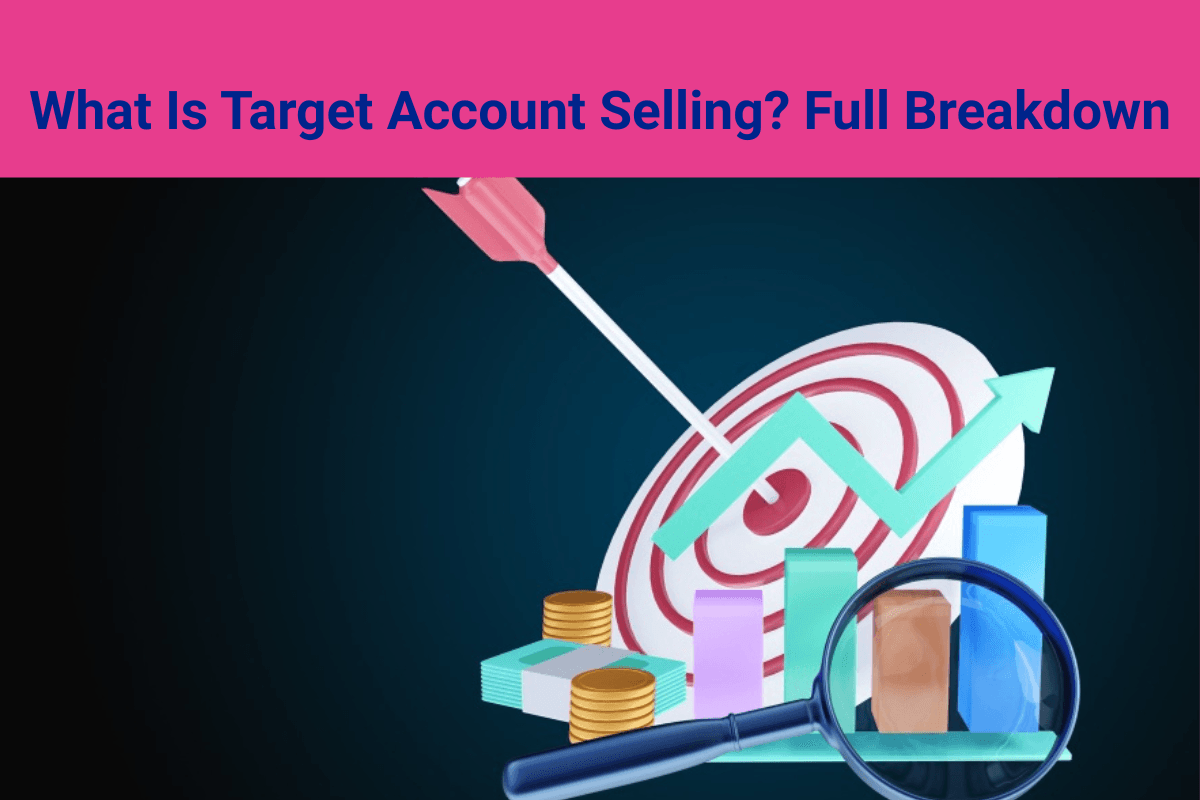
Add Table of Contents
TL;DR
|
You’re sending emails, chasing leads, and running campaigns, yet deals stall, prospects ghost, and the wrong accounts keep clogging your pipeline. The problem isn’t effort. It’s the focus. Target Account Selling (TAS) helps you zero in on the accounts that truly matter; the ones with a budget, authority, and a real problem your solution solves.
It’s not just a sales strategy; it’s how modern revenue teams win. In this blog, we’ll show you how to stop wasting time on low-fit leads and start building a pipeline filled with high-value accounts that convert faster, close bigger, and stick around longer.
What is Target Account Selling?
Why chase every lead when you can target the ones that actually close? Account targeting is about targeting high-value clients; the ones who match your ideal customer profile and move the revenue needle easily. No more cold sprays. Just laser focus on the accounts that matter.
This isn’t guesswork. It’s a strategy. You dig into what each account struggles with, identify the key players, and determine how your solution fits perfectly into their world.
Every message resonates differently because it’s tailored to each individual. The result? Less noise, more wins, and deals that don’t just close; they stick.
Also read our blog on 7 steps for a high-impact account-based marketing strategy.
When to Use Target Account Selling?
Target account selling isn’t for quick wins; it’s for big wins. If your team is pursuing complex deals, enterprise clients, or slow-moving pipelines, this strategy helps you focus on where it matters most. It’s ideal when your sales cycles are long, stakeholders are many, and precision is everything.
Use target account selling when:
You’re going after high-value or enterprise clients: These deals involve multiple decision-makers and require a tailored, strategic approach.
Sales cycles are long and complex: Are you tired of deals stalling? TAS helps map and influence every key contact.
You need to align sales and marketing: Both teams collaborate on in-depth research and account-specific campaigns.
Your current approach isn’t converting: Spray-and-Pray isn't working. TAS brings structure and focus to close the right deals.
You want long-term, high-retention clients: It’s about quality over quantity. Building lasting partnerships, not one-off sales.
Why Choose Target Account Selling?
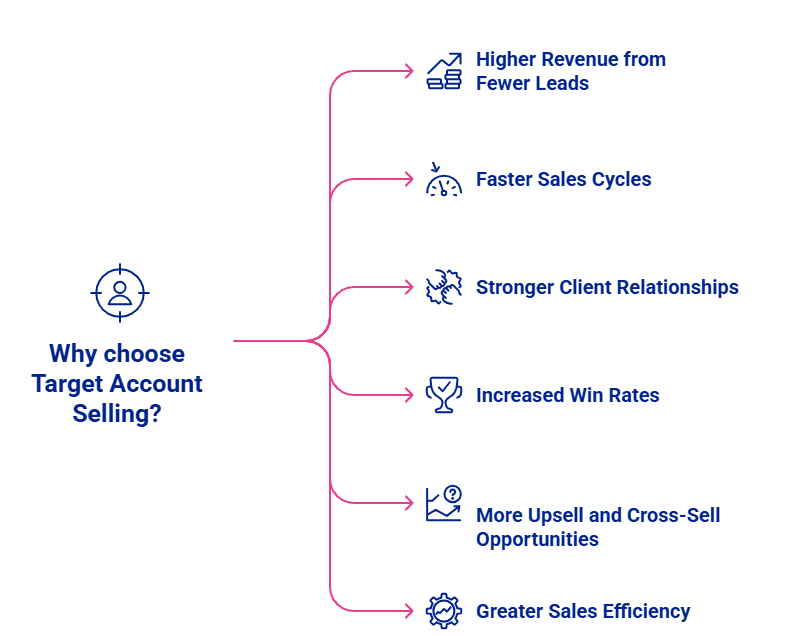
Target Account Selling delivers tangible, revenue-driving benefits that go beyond basic outreach. Here’s what makes it a powerful strategy for modern sales teams:
Higher Revenue from Fewer Leads: By focusing only on high-value accounts, your team can close bigger deals without chasing volume.
Faster Sales Cycles: Targeted outreach and tailored messaging help move decision-makers more quickly through the sales pipeline.
Stronger Client Relationships: Personalized engagement demonstrates to prospects that you understand their needs, fostering trust and long-term loyalty.
Increased Win Rates: When your solution addresses an account’s specific pain points, you stand out and win more often.
More Upsell and Cross-Sell Opportunities: Deeper relationships with key accounts open doors to expansion without the need for new lead generation.
Greater Sales Efficiency: Time and resources are spent where they count, reducing waste and improving overall team performance.
What Are Some Challenges in Target Account Selling?
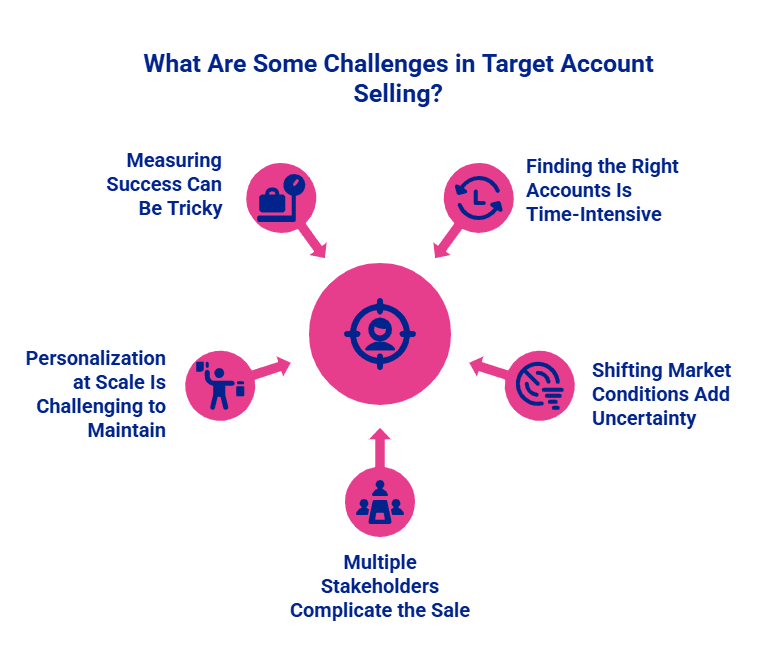
Account targeting delivers results, but it comes with its share of challenges. To succeed, sales teams must navigate these common roadblocks:
Finding the Right Accounts Is Time-Intensive: Without a well-defined ideal customer profile, sales reps may waste effort on accounts with little revenue potential.
Shifting Market Conditions Add Uncertainty: Economic changes and industry trends can quickly impact which accounts are worth pursuing, requiring constant adaptability.
Multiple Stakeholders Complicate the Sale: Enterprise deals often involve multiple decision-makers, making it more challenging to align messaging and progress deals forward.
Personalization at Scale Is Challenging to Maintain: Customizing outreach for each account requires significant time and resources, especially when managing a large book of business.
Measuring Success Can Be Tricky: Without clear analytics or attribution tools, it’s difficult to track ROI and prove the effectiveness of account targeting efforts.
How to Implement Target Account Selling in Your Sales Strategy?
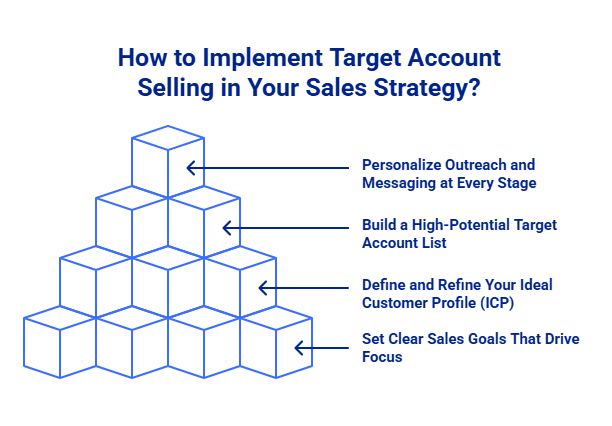
Target Account Selling is most effective when supported by clear goals, a sharp focus, and tight coordination across teams. Here’s how to put it into action strategically and effectively:
1. How Do You Set Clear Sales Goals That Drive Focus?
Begin by setting specific business goals. Are you targeting revenue growth from enterprise accounts? Trying to shorten sales cycles? Whatever the priority, tie it to key metrics such as win rate, deal size, or customer retention.
This clarity helps teams prioritize what matters most.
For example, if Q4 is about breaking into fintech, every effort should be aligned around that vertical.
2. How Do You Define and Refine Your Ideal Customer Profile (ICP)?
Your ICP is your sales compass; it tells you exactly who to target.
Include traits like company size, industry, tech stack, and everyday challenges. The tighter the definition, the less guesswork for your team.
Let's say you sell compliance software, then your ideal customer profile (ICP) might include mid-market healthcare firms struggling with HIPAA audits.
3. How Do You Build a High-Potential Target Account List?
Now, turn that ICP into a smart list of accounts. Use data tools, CRM insights, and buying signals (like pricing page visits or webinar signups) to identify who’s worth the effort.
Segment your list by priority:
Tier 1: Full personalization
Tier 2: Light customization
Tier 3: Automated nurture
Don't forget to update the list regularly as account behavior shifts.
4. How Do You Personalize Outreach and Messaging at Every Stage?
Generic pitches don’t close big deals. Utilize account-level research to tailor every touchpoint, including emails, ads, LinkedIn messages, and follow-ups.
Saw they just raised funding? Lead with how you help post-series growth. Notice a recent churn in their team? Show how your solution adds stability.
Example: If a target account just hired a new CTO, your outreach could say: “We’ve helped other tech leaders in their first 90 days streamline vendor evaluations, thought this might help as you build out your roadmap.”
Continue to evolve the message as the account progresses through the funnel.
What Are the 5 Proven Strategies to Implement Target Account Selling?
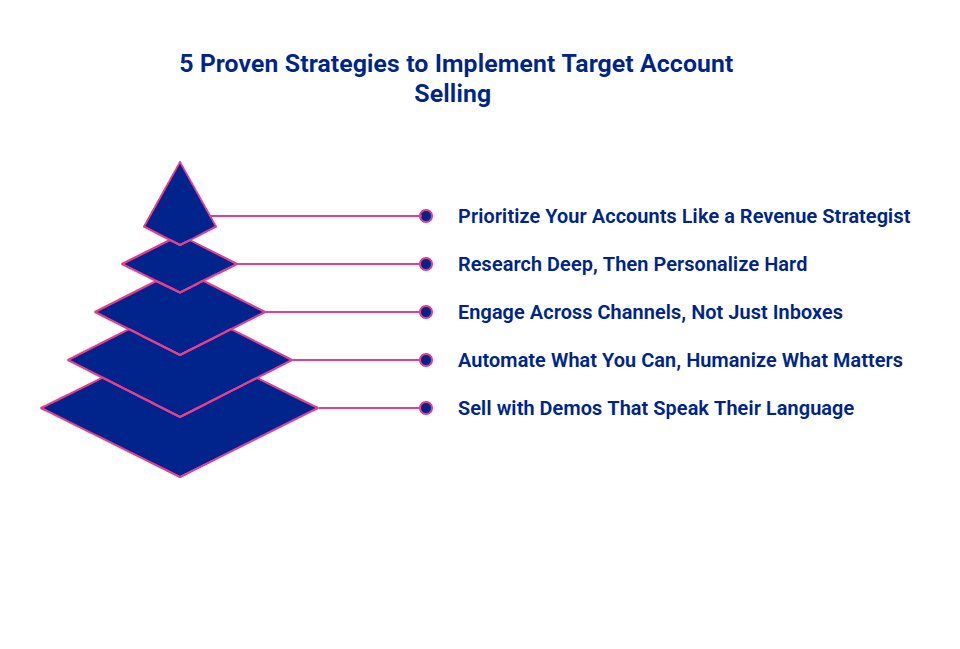
Target Account Selling (TAS) is most effective when strategy aligns with execution. These five practical approaches will help you move from broad outreach to focused, high-converting sales plays.
1. How Do You Prioritize Your Accounts Like a Revenue Strategist?
Not all accounts require the same level of time and attention. Start by segmenting based on revenue potential, industry relevance, or buying signals. This ensures that your best-fit accounts receive the effort they deserve.
Tier your list; Tier 1 gets full personalization; Tier 2 gets scalable engagement, and so on. This structure prevents resource drain and improves win rates where it matters most.
For example, a software vendor might prioritize VC-funded SaaS startups in hypergrowth. These accounts offer higher returns and faster buying cycles, making them worth the red carpet treatment.
2. Why Should You Research Deep, Then Personalize Hard?
Surface-level information won’t suffice in account-based selling. Go beyond job titles and LinkedIn profiles; dig into org charts, past vendors, pain points, and recent changes.
When you understand what drives an account, you can speak directly to its objectives. “We help teams like yours reduce churn by 30% in under 60 days” beats a cold pitch any day.
If the CMO just rolled out a new brand strategy, your pitch should reflect how your product aligns with that shift.
3. Why Engaging Across Channels, Not Just Inboxes, Matters?
Today’s buyers don’t live in one place, and your outreach shouldn’t either. Layer your approach with email, LinkedIn, custom ads, and even direct mail for a truly comprehensive effect.
Sales and marketing should work in sync to deliver a cohesive experience. Imagine a LinkedIn post sparking interest, followed by an email offering a case study relevant to that exact company.
The goal? Stay visible, build familiarity, and guide the account through the journey with intent, not by chance. Multi-channel means multi-touch, which means more traction.
4. What's the Secret to Automating What You Can, Humanizing Only What Matters?
TAS is not scalable without smart automation. Let tools handle repetitive tasks like follow-ups, meeting scheduling, and lead tracking so your reps can stay strategic.
But automation alone isn't enough. Combine it with team-wide alignment between sales, marketing, and customer success. One CRM, shared data, unified messaging; it’s the difference between a pitch and a partnership.
For instance, while your CRM sends a reminder email, your rep follows up with a personalized voice note referencing the prospect’s latest product launch. That’s efficiency with a human touch.
5. How Do You Sell with Demos That Speak Their Language?
A generic product demo kills momentum. What works? A demo tailored to your prospect’s actual workflow, pain point, or use case, ideally with interactive elements.
If you're selling to a RevOps leader, show exactly how your tool streamlines reporting across teams. Don’t explain it; demonstrate it.
Use platforms like SmartCue to let sales reps create interactive, no-code demos tailored to each prospect’s specific needs and business challenges. It aligns perfectly with the Target account selling plan and modern sales methodology. This approach strengthens sales efforts while fostering relationships that convert more quickly.
Can SmartCue Really Help You Win High-Value Accounts Faster?
Target Account Selling relies on relevance, and SmartCue makes it easy to deliver. With SmartCue, your sales reps can build personalized, no-code demos tailored to each account’s specific pain points and goals; no waiting on product or engineering.
These demos aren’t one-size-fits-all. They’re interactive walkthroughs that reflect the buyer’s world, industry context, use case, and role-specific value. This level of personalization builds instant credibility.
SmartCue fits seamlessly into your TAS process. Use it from early outreach to late-stage pitches, turning demos into a strategic asset across every touchpoint.
The result? More engagement, stronger relationships, and shorter deal cycles, especially with high-value accounts that expect more than just a slide deck. Take the 14-day free trial now!
Conclusion
Traditional sales tactics are no longer effective, especially when targeting key decision-makers with specific goals. Targeted account selling enables you to reach the right prospects at the right time with messaging that aligns with their business model and buyer personas.
Success starts with knowing your customer’s business and pain points better than they do. Align marketing teams, tailor outreach, and optimize the customer experience across every touchpoint from social media to personalized demos.
The first step is clarity: identify your best-fit accounts. The next step is execution; use tools that solve your customer’s needs. Follow the playbook. Build strong relationships. And close deals that actually move the needle.
Frequently Asked Questions
What types of companies benefit most from target account selling?
Companies that want to work with key accounts or large clients benefit significantly from TAS. Many kinds of businesses in different industries use it when they need to put more effort into securing deals with tough or complex decision-making processes. If your business primarily focuses on key accounts or you aim to increase revenue, TAS is a suitable fit for you. This way, you can increase your revenue by using the TAS method.
How can you measure the success of a target account selling approach?
Success metrics for TAS focus on key indicators such as revenue growth, improved conversion rates, shorter sales cycles, and increased customer satisfaction. Analytics tools help track buying intent and customer data. These tools show the return on investment and help you change your campaigns as needed.
What’s the difference between TAS and ABM?
While ABM focuses marketing efforts on a single account, TAS brings marketing and sales together to form one clear plan. TAS helps both marketing and sales teams work toward winning top customer deals.
When is the right time to implement account targeting and target account selling?
The right time to implement account targeting and a TAS strategy is when your sales process shifts from volume to value, where building relationships, deep research, and engaging key decision makers matter more than traditional sales models in generating revenue.
What are the key benefits of implementing a target account selling strategy?
A TAS strategy helps align your sales approach to the unique needs of best-fit accounts. By using intent data, account research, and demo automation platforms, you boost chances of success, deliver tailored demo experiences, and guide purchase decisions with a targeted approach that outperforms broad sales funnel tactics.
Comments
Your comment has been submitted successfully!